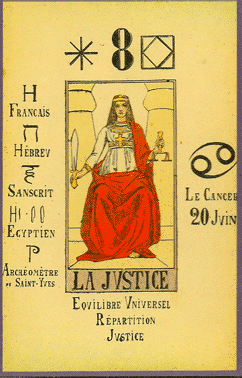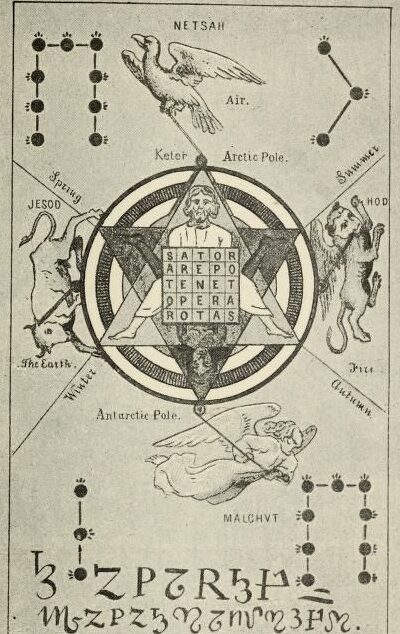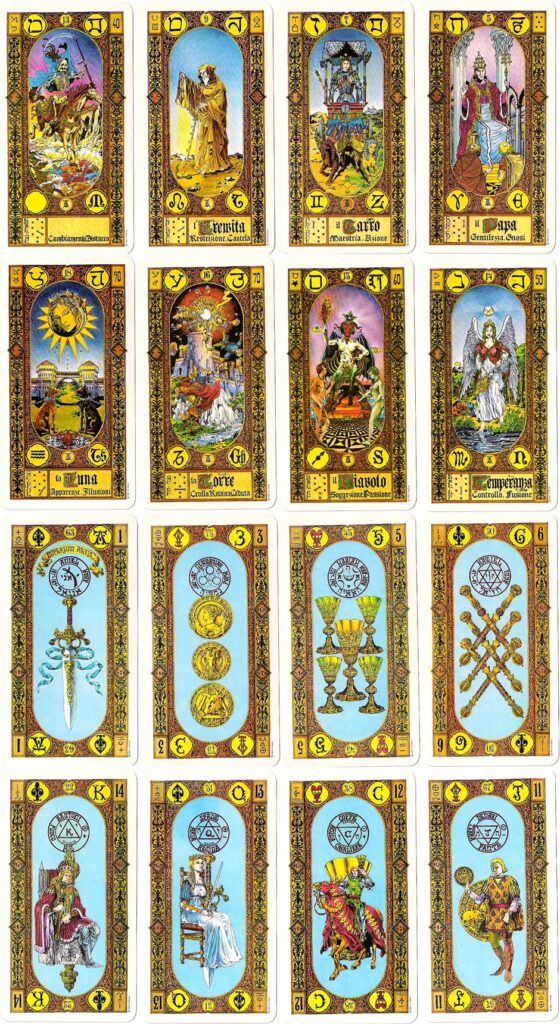The Papus Tarot is an amazing combination of Strength and Wisdom. It reminds me of the ancient, glorious sword of some great warrior, put into a scabbard which darkened with time, adorned with embossed ligature of great names.
The creator of the deck is Doctor Papus, a French occultist, magician and physician, founder of the Martinist Order and a member of the Kabbalistic Order of the Rose Cross. The system of Dr. Papus was later adopted in many countries. The Papus branch became known as the Papus School.
CHARACTERISTIC
Author: Papus (Gerard Anaclet Vincent Encausse)
Artists: Gabriel Gulinat, Olivier Stephane
Tradition: French School (Papus)
Major Arcana: The Fool 21 (0), Strength 8, Judgment 11
Minor arcana: Suit symbols
Suits: Wands, Cups, Swords, Pentacles
Court Cards: Page, Knight, Queen, King
HISTORY
I must say that Papus did not develop his Tarot deck alone. Other occultists and tarologists also worked with him. They helped each other and influenced Papus’ decisions. For example, in St. Petersburg Papus founded the Martin Lodge, where the tarologist O. G. Möbes was its chairman, and there the magazine “Isis” was published by the Martinists, which published all the occultists of that era.

They adhered to the theory that the Tarot came to us from Ancient Egypt, and they came to Egypt itself from ancient Atlantis, as an integral part of the ancient secret knowledge. Hence some of the names of the cards. For example, the 3rd card of the Major Arcana is called Isis.
Before Papus, there were two schools in the Tarot card system at that time, from which the later schools of the Tarot systems originated. It was the French school of Eliphat Levi and the English school of Mathers. It was on their basis that the famous Tarot schools of Papus and White appeared. The Papus Tarot school is sometimes referred to as a French school, and sometimes singled out as an Egyptian one.
In 1909 Papus published the book “Predictive Tarot”, which became the classic guide for cards of this type. In this book, Papus reports that his work is a complete restoration of the Egyptian Tarot. The deck of cards issued for this book were black and white, painted in the genre of classical hermeticism. Artist Gabriel Gulinat has combined elements from drawings by Etteila, Levi and Wirth in his illustrations.
But nevertheless, in 1889, Papus publishes a book called “The Gypsy Tarot”, which describes the already classic deck of Tarot cards. This deck has 22 Major Arcana and the rest of the Minor Arcana. In the same year, Wirth’s book was also published with exactly the same deck. Both Papus and Wirth were followers of Elisfat Levi, who is considered the creator of a holistic system of Tarot cards. It was he who combined the Tarot system with cabalism. In these cards, the Major Arcana also correspond to the elements, signs of the zodiac and planets. It was these cards that served as a fulcrum for the development of Tarot schools in France, Russia and Germany.
The Papus’ deck of Tarot cards that was released in 1989 was already in color. The artist Olivier Stéphane painted the cards, which were issued in black and white. And in 1990, the cards were already reworked by an unknown Russian artist, who reworked Olivier Stefan’s cards, but as a result, these cards began to differ greatly from the original Tarot cards of Papus.
PECULIARITIES
The Major Arcana of this deck are designated by the letters of the Hebrew alphabet, as in Eliphat Levi. They are also compared with the four elements of Water, Earth, Fire and Air, have a correspondence with the seven planets of the solar system.
ARTISTIC VIEW
Artistic design of cards combines graphic asceticism and color saturation. The images on the cards are very schematic, the Minor Arcana are completely devoid of thematic drawings that help beginners to catch the nuances of interpretation, but the colors are bright, rich and monochrome, like on the paintings of ancient tribes. The streams coming from the cards are also pristinely pure, and catching them while working with the deck literally rests your soul, as if an invisible master re-tunes the strings to an accurate and clean sound, removing all errors and falsity.
Papus Tarot – Isis
As Papus himself believed, the Egyptian version of the origin of the Tarot cards was the most probable. He was sure that the amazing knowledge that the deck hides came to the territory of Ancient Egypt from Atlantis. In his work, which is called “The Predictive Tarot”, the author points to the deity of truth, Isis, claiming that the 2nd Arcana is her temple.
According to his reasoning, the 3rd Arcana could be called the Heavenly Isis. The scepter depicted on the 4th Arcana was the scepter of Isis. The author invested special symbolism in the 2nd Arcana, which is often called the Papesse.
The very influence of this goddess on Papus is noticeable, since her reflection is in many of his works. In 1890, the occultist founded the magazine “Isis”, and in 1909, members of the Martinist Order, which was founded by Papus, open another magazine “Isis”. It is the official press organ of the Martinists, which continues to publish translations of the works of Papus.

Gypsy Tarot
Fame came to Papus in 1889 after the publication of the book “Gypsy Tarot”, which became a classic. Oswald Wirth created drawings for the 22 Major Arcana of this deck.
They were assigned astrological symbols, which were taken from the Kabbalistic work of Sefer Yetzirah. Also, the 22 letters of the Hebrew alphabet, verses, seven heavenly bodies and 12 signs of the Zodiac were correlated with the Major Arcana.
FAMILY OF DECKS
Here are some of the types of Tarot decks that belong to the Papus system:
Tarot of the Twelve Rays
This deck was created by the Russian Tarot school “Isis’s Gate” based on the traditions of the French school of Papus. The deck contains a white card. The author is Isset Kotelnikova.
Publisher: School of Tarot “Gates of Isis”.
GOM Kabbalistic Tarot
At the heart of the deck is the book by Grigory Ottonovich Möbes “The Course of the Encyclopedia of Occultism” (Major Arcana), who worked under the pseudonym G.О.М. When creating the descriptions of the Major Arcana, Grigory Ottonovich relied on the works of Papus, Knorr von Rosenkroth and Lenin. Therefore, in his book initially there were only the Major Arcana. The authors of the decoration had to draw the Minor Arcana on their own.
Publisher: Enigma
Tavaglione Stairs of Gold Tarot Deck Cards
One of the most famous and deservedly popular Tarot decks. The glyphs of the Great Arcana are fully consistent with the classical tradition. Minor Arcana do not have plot pictures, they just depict suit symbols in the appropriate amount. Each card indicates the available astrological, numerological and Kabbalistic correspondences to this Arcana. The author of the deck is Giorgio Tavallone, an Italian illustrator and esoteric scholar.
Publisher: US Games, AGMuller
Enoil Gavat Tarot
Another deck by Maestro Giorgio Tavallone. It was created in the classical traditions of the Papus school, with all the Kabbalistic symbols. This is a rare deck, one of 4 decks created by Maestro Giorgio Tavallone.
Production: Italy

As the tarologists say, these cards are difficult for beginners. But as Papus himself pointed out, these cards can have their own character, they themselves are connected to energy channels. For those who take them in hand, do not meditate too long. You just need to get in touch with the cards themselves.
Papus Tarot cards are a unique heritage that will help shed light on the most interesting questions and find out what the human soul hides.
What is a Papus Tarot deck?
The Papus Tarot is an amazing combination of Strength and Wisdom. It reminds me of the ancient, glorious sword of some great warrior, put into a scabbard which darkened with time, adorned with embossed ligature of great names.
The creator of the deck is Doctor Papus, a French occultist, magician and physician, founder of the Martinist Order and a member of the Kabbalistic Order of the Rose Cross. The system of Dr. Papus was later adopted in many countries. The Papus branch became known as the Papus School.
CHARACTERISTIC
Author: Papus (Gerard Anaclet Vincent Encausse)
Artists: Gabriel Gulinat, Olivier Stephane
Tradition: French School (Papus)
Major Arcana: The Fool 21 (0), Strength 8, Judgment 11
Minor arcana: Suit symbols
Suits: Wands, Cups, Swords, Pentacles
Court Cards: Page, Knight, Queen, King
HISTORY
I must say that Papus did not develop his Tarot deck alone. Other occultists and tarologists also worked with him. They helped each other and influenced Papus’ decisions. For example, in St. Petersburg Papus founded the Martin Lodge, where the tarologist O. G. Möbes was its chairman, and there the magazine “Isis” was published by the Martinists, which published all the occultists of that era.

They adhered to the theory that the Tarot came to us from Ancient Egypt, and they came to Egypt itself from ancient Atlantis, as an integral part of the ancient secret knowledge. Hence some of the names of the cards. For example, the 3rd card of the Major Arcana is called Isis.
Before Papus, there were two schools in the Tarot card system at that time, from which the later schools of the Tarot systems originated. It was the French school of Eliphat Levi and the English school of Mathers. It was on their basis that the famous Tarot schools of Papus and White appeared. The Papus Tarot school is sometimes referred to as a French school, and sometimes singled out as an Egyptian one.
In 1909 Papus published the book “Predictive Tarot”, which became the classic guide for cards of this type. In this book, Papus reports that his work is a complete restoration of the Egyptian Tarot. The deck of cards issued for this book were black and white, painted in the genre of classical hermeticism. Artist Gabriel Gulinat has combined elements from drawings by Etteila, Levi and Wirth in his illustrations.
But nevertheless, in 1889, Papus publishes a book called “The Gypsy Tarot”, which describes the already classic deck of Tarot cards. This deck has 22 Major Arcana and the rest of the Minor Arcana. In the same year, Wirth’s book was also published with exactly the same deck. Both Papus and Wirth were followers of Elisfat Levi, who is considered the creator of a holistic system of Tarot cards. It was he who combined the Tarot system with cabalism. In these cards, the Major Arcana also correspond to the elements, signs of the zodiac and planets. It was these cards that served as a fulcrum for the development of Tarot schools in France, Russia and Germany.
The Papus’ deck of Tarot cards that was released in 1989 was already in color. The artist Olivier Stéphane painted the cards, which were issued in black and white. And in 1990, the cards were already reworked by an unknown Russian artist, who reworked Olivier Stefan’s cards, but as a result, these cards began to differ greatly from the original Tarot cards of Papus.
PECULIARITIES
The Major Arcana of this deck are designated by the letters of the Hebrew alphabet, as in Eliphat Levi. They are also compared with the four elements of Water, Earth, Fire and Air, have a correspondence with the seven planets of the solar system.
ARTISTIC VIEW
Artistic design of cards combines graphic asceticism and color saturation. The images on the cards are very schematic, the Minor Arcana are completely devoid of thematic drawings that help beginners to catch the nuances of interpretation, but the colors are bright, rich and monochrome, like on the paintings of ancient tribes. The streams coming from the cards are also pristinely pure, and catching them while working with the deck literally rests your soul, as if an invisible master re-tunes the strings to an accurate and clean sound, removing all errors and falsity.
Papus Tarot – Isis
As Papus himself believed, the Egyptian version of the origin of the Tarot cards was the most probable. He was sure that the amazing knowledge that the deck hides came to the territory of Ancient Egypt from Atlantis. In his work, which is called “The Predictive Tarot”, the author points to the deity of truth, Isis, claiming that the 2nd Arcana is her temple.
According to his reasoning, the 3rd Arcana could be called the Heavenly Isis. The scepter depicted on the 4th Arcana was the scepter of Isis. The author invested special symbolism in the 2nd Arcana, which is often called the Papesse.
The very influence of this goddess on Papus is noticeable, since her reflection is in many of his works. In 1890, the occultist founded the magazine “Isis”, and in 1909, members of the Martinist Order, which was founded by Papus, open another magazine “Isis”. It is the official press organ of the Martinists, which continues to publish translations of the works of Papus.

Gypsy Tarot
Fame came to Papus in 1889 after the publication of the book “Gypsy Tarot”, which became a classic. Oswald Wirth created drawings for the 22 Major Arcana of this deck.
They were assigned astrological symbols, which were taken from the Kabbalistic work of Sefer Yetzirah. Also, the 22 letters of the Hebrew alphabet, verses, seven heavenly bodies and 12 signs of the Zodiac were correlated with the Major Arcana.
FAMILY OF DECKS
Here are some of the types of Tarot decks that belong to the Papus system:
Tarot of the Twelve Rays
This deck was created by the Russian Tarot school “Isis’s Gate” based on the traditions of the French school of Papus. The deck contains a white card. The author is Isset Kotelnikova.
Publisher: School of Tarot “Gates of Isis”.
GOM Kabbalistic Tarot
At the heart of the deck is the book by Grigory Ottonovich Möbes “The Course of the Encyclopedia of Occultism” (Major Arcana), who worked under the pseudonym G.О.М. When creating the descriptions of the Major Arcana, Grigory Ottonovich relied on the works of Papus, Knorr von Rosenkroth and Lenin. Therefore, in his book initially there were only the Major Arcana. The authors of the decoration had to draw the Minor Arcana on their own.
Publisher: Enigma
Tavaglione Stairs of Gold Tarot Deck Cards
One of the most famous and deservedly popular Tarot decks. The glyphs of the Great Arcana are fully consistent with the classical tradition. Minor Arcana do not have plot pictures, they just depict suit symbols in the appropriate amount. Each card indicates the available astrological, numerological and Kabbalistic correspondences to this Arcana. The author of the deck is Giorgio Tavallone, an Italian illustrator and esoteric scholar.
Publisher: US Games, AGMuller
Enoil Gavat Tarot
Another deck by Maestro Giorgio Tavallone. It was created in the classical traditions of the Papus school, with all the Kabbalistic symbols. This is a rare deck, one of 4 decks created by Maestro Giorgio Tavallone.
Production: Italy

As the tarologists say, these cards are difficult for beginners. But as Papus himself pointed out, these cards can have their own character, they themselves are connected to energy channels. For those who take them in hand, do not meditate too long. You just need to get in touch with the cards themselves.
Papus Tarot cards are a unique heritage that will help shed light on the most interesting questions and find out what the human soul hides.
Discover more from Esoteric Hut
Subscribe to get the latest posts sent to your email.


This article really opened my eyes to the Papus Tarot deck! I had heard of it before, but I didn’t realize just how deeply rooted it is in esotericism and occult philosophy. Learning about its origins and unique symbolism gave me a whole new appreciation for the depth of meaning that Tarot cards can hold. It’s fascinating to see how different decks can offer diverse perspectives and insights into the human experience. I’m definitely intrigued to explore the Papus Tarot further and see what wisdom it has to offer.